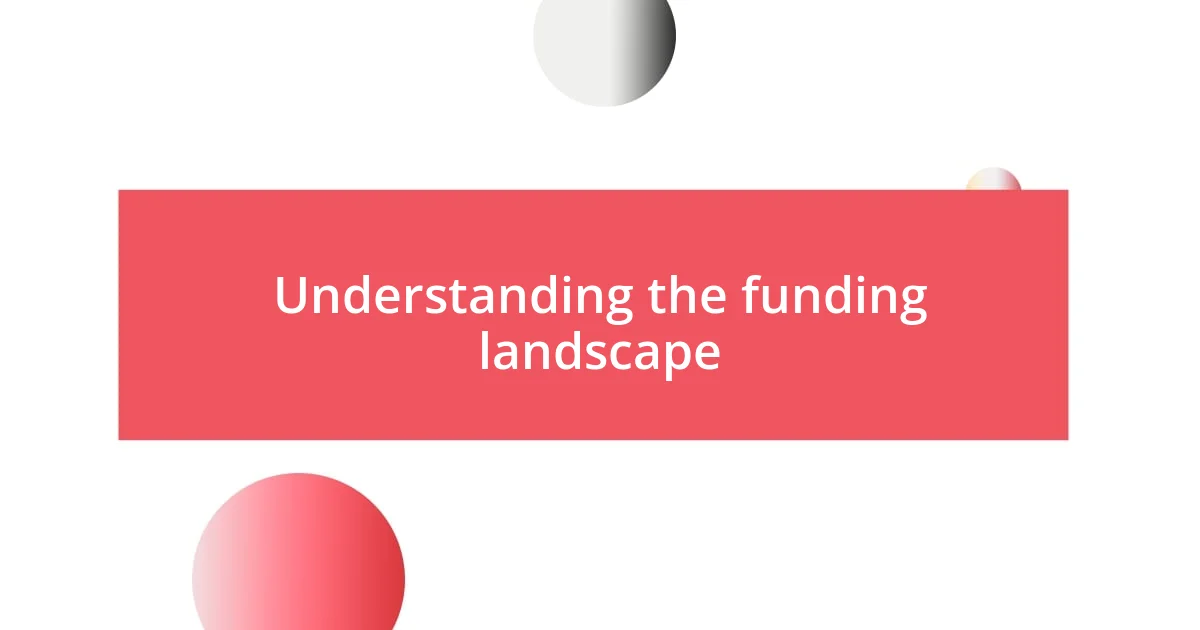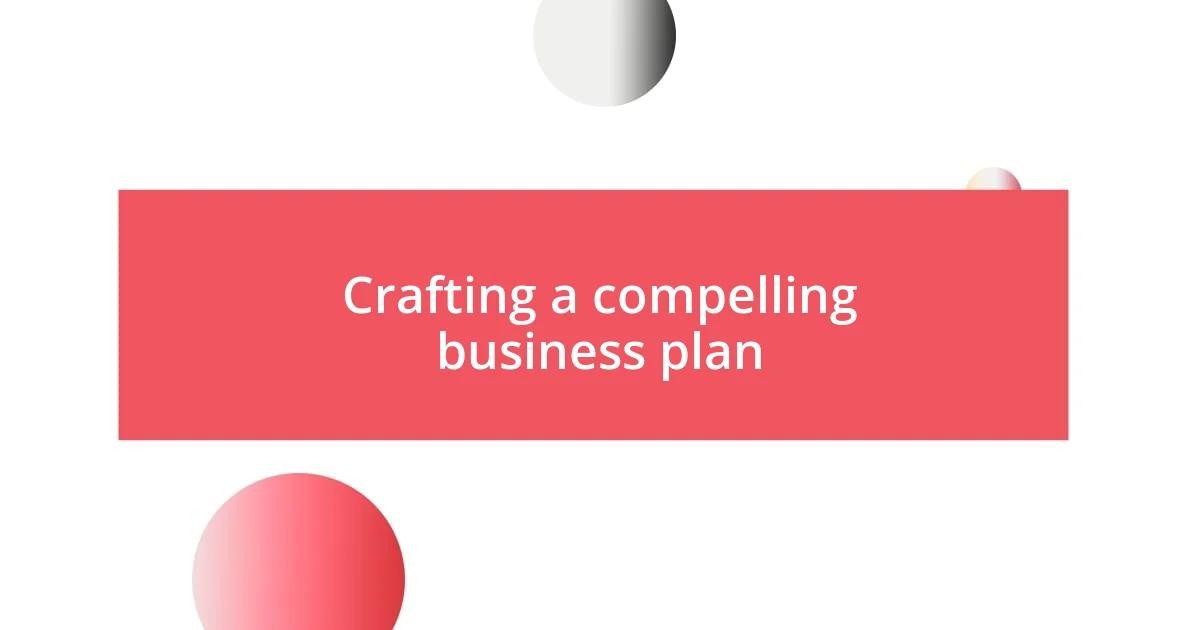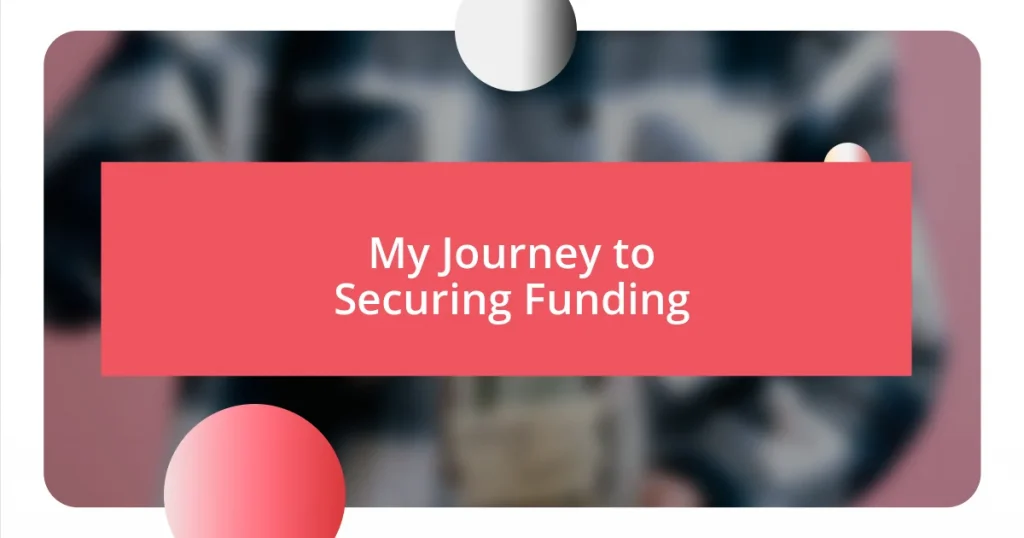Key takeaways:
- Understanding your funding landscape involves evaluating various options, including grants and equity financing, and recognizing the impact of relationships associated with them.
- Identifying personal funding needs requires categorizing them by urgency and importance to prioritize financial strategies effectively.
- Learning from funding rejections can transform setbacks into opportunities for growth by seeking feedback and applying self-reflection for continual improvement.

Understanding the funding landscape
Navigating the funding landscape can be quite overwhelming. I remember when I first dipped my toes into it; I felt like a small boat in a vast ocean of opportunities. Where do you even start? It’s a question I often hear, as so many people struggle to identify the right sources and types of funding that align with their visions.
There are various funding options available, from grants to venture capital, and each comes with its own set of expectations and obligations. I once applied for a grant that seemed perfect at first glance. However, I soon realized the extensive reporting requirements left me with more stress than support. This taught me to look beyond the funding amount and consider the entire relationship I’d be entering into – something that many aspiring entrepreneurs overlook.
Equity financing can be particularly enticing but also daunting. I speak from experience when I say that giving up even a small percentage of ownership can feel like a big deal. Have you ever pondered how much control you’re willing to trade for funding? It’s crucial to balance your financial needs with your long-term vision, and understanding the nuances of the funding landscape can help you make more informed decisions.

Identifying personal funding needs
Identifying your personal funding needs is really about reflecting on where you stand and where you want to go. I remember sitting down with a pen and paper, jotting down my immediate financial requirements versus my long-term goals. It was an enlightening moment; I realized I needed to consider not just current expenses, like product development, but also future needs, such as marketing strategies and talent acquisition.
One crucial aspect I learned is to categorize funding needs by urgency and importance. For instance, do you need immediate cash flow for operations, or are you seeking investment for innovative projects that could bring significant returns later? The contrast can be stark; I once chased after a funding opportunity that seemed urgent but wasn’t aligned with my strategic direction, and it ended up being a distraction rather than a beneficial stepping stone.
To give you a clearer picture, here’s how I categorize my funding needs in a structured way:
| Category | Description |
|---|---|
| Immediate Needs | Funds required for day-to-day operations, essential expenses. |
| Strategic Investment | Funds for long-term projects that enhance growth and innovation. |
| Emergency Reserves | Backup funds to cover unexpected costs or downturns. |
| Future Expansion | Investment for scaling up or entering new markets. |
By breaking down my funding needs this way, I could prioritize and focus on what truly mattered for my journey. It helped me gain clarity and avoid the pitfalls of chasing after inappropriate funding sources.

Crafting a compelling business plan
Crafting a compelling business plan is one of the most critical steps in my journey to securing funding. When I first drafted my business plan, I felt like I was writing a love letter to my idea, pouring my heart and soul into it. It was essential for me to not only articulate my vision but also clearly outline my goals, strategies, and financial projections. Investors want to see that you’ve thought through the details and understand how you plan to navigate challenges along the way.
- Executive Summary: A concise overview of the business, including mission, vision, and what makes it unique.
- Market Analysis: Research that shows your understanding of the market landscape and target audience.
- Financial Projections: Detailed financial forecasts that illustrate potential profitability and return on investment.
- Marketing Strategy: A clear plan on how you intend to reach your audience and drive sales.
- Milestones: Concrete goals and timelines to highlight your progress and intentions.
While writing my plan, I learned that details really matter. I remember stitching together numbers and facts that initially felt overwhelming, but ultimately gave me confidence. Once, when I shared my draft with a mentor, he pointed out parts where I didn’t demonstrate enough research, which evoked a mix of embarrassment and determination in me. It was a wake-up call that constructive feedback could strengthen my business plan. That experience taught me that vulnerability can lead to growth, especially when you’re developing something as crucial as a business strategy.

Networking with potential investors
Building relationships with potential investors has been a game-changer for my journey. I vividly remember my first networking event; I was filled with equal parts excitement and nerves. Approaching seasoned investors felt daunting, but I discovered that a sincere conversation often opened doors. Sometimes, I asked questions that seemed simple, like “What drew you to the industry?” This not only sparked engaging discussions but also helped me understand their perspective and preferences.
Attending meetings and conferences where I could meet investors face-to-face was another strategy that paid off. One time, at a startup meetup, I struck up a conversation with an investor who shared invaluable insights on navigating funding rounds. I learned that it’s crucial to approach these interactions authentically rather than just rehearsing a pitch. I found that sharing my story and passion resonated more than statistics alone. Have you ever felt that people connect more with your journey than with the numbers? I certainly have.
Following up after these events is just as important as the initial encounter. I committed to sending personalized thank-you notes, sometimes referencing specific conversations we had, which helped keep the connection alive. This personal touch not only shows appreciation but also reinforces my genuine interest in building a lasting relationship. I can’t stress enough how important it is to cultivate these connections over time, understanding that today’s conversation could lead to future opportunities.

Perfecting your pitch presentation
Perfecting your pitch presentation is an art that requires practice and passion. I discovered that the most effective presentations aren’t just about delivering facts; they’re about telling a story that captivates your audience. During one of my early pitches, I noticed how sharing a personal anecdote about overcoming challenges in my entrepreneurial journey drew in my listeners. It transformed a dry presentation into a heartfelt narrative, which undoubtedly made a lasting impression on the investors in the room.
I often think about the importance of visual aids in a pitch. When I included engaging visuals—like infographics and charts—my audience seemed more involved and focused. I recall a specific instance where a simple, well-designed slide illustrating my market potential led to spirited discussions. Have you thought about how images can evoke emotions and make complex ideas digestible?
Moreover, practicing my delivery became a crucial aspect of my preparation. I remember rehearsing in front of a mirror, tweaking my inflection and body language to ensure I conveyed confidence. The difference was palpable; I felt more at ease when the actual day arrived. It’s a unique experience to see how your nervousness can turn into excitement. When I finally stepped onto that stage and delivered my pitch, it felt exhilarating—like I was sharing a secret dream with potential partners.

Following up and managing relationships
One of the most impactful aspects of following up is timing. After an event, I found that sending a message within 48 hours keeps the connection fresh in both our minds. I remember reaching out to an investor after a panel discussion, recalling a particularly funny moment we shared during Q&A. This not only made my note memorable but also helped establish a rapport that went beyond a surface-level interaction.
Managing relationships goes beyond occasional check-ins. I set reminders to follow up every few months, sharing relevant articles or updates about my journey. This approach not only positions me as someone who values the relationship but also keeps my name on their radar. I think back to a time when I shared an article relevant to an investor’s interests; it led to a spontaneous coffee meeting that turned into a deep conversation about future collaboration. Have you ever experienced how a little gesture can spark unexpected opportunities?
Ultimately, it’s about nurturing the relationship. I see each interaction as a branch growing on a tree, where genuine interest and kindness help it flourish. I’ve learned to ask thoughtful questions during our conversations, which not only shows I’m invested but also encourages them to share more about their experiences. This two-way street often opens doors to collaboration, and I can’t help but feel grateful for the authenticity that builds these crucial connections over time.

Learning from funding rejections
Learning from funding rejections is one of the hardest but most rewarding experiences. There was a time when I received a rejection that stung deeply. I remember sitting with my laptop, poring over the feedback, and feeling a mix of disappointment and determination. What struck me the most was the pointed advice on my business model. It made me realize that each rejection wasn’t just an obstacle; it was a stepping stone towards refinement. Have you ever experienced a moment like that, where a setback pushed you to think differently?
In my journey, I began to view rejections as valuable lessons rather than personal failures. After one particularly tough rejection, I decided to seek out feedback from those who had turned me down. I was surprised at how open many of them were to share insights. This new approach not only helped me improve my proposal but also fostered a sense of resilience within me. I can’t help but wonder how many people miss out on this opportunity simply because they’re too disheartened to ask for help.
Sometimes, it’s easy to let negative emotions overshadow your drive, but I’ve learned that self-reflection is crucial. I took time after each rejection to analyze my pitch’s strengths and weaknesses. One time, I scribbled down thoughts in a journal, detailing what went wrong and how I felt. This act became therapeutic, guiding me to understand that persistence and adaptability are vital in the world of funding. How do you cope when faced with setbacks? I’ve discovered that finding lessons in those experiences not only solidified my resolve but made each step forward feel more meaningful.















